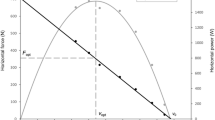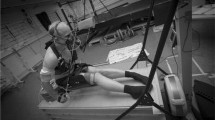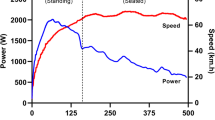Abstract
This investigation examined the relationship between gear ratio and peak and mean power outputs (PPO and MPO) and peak cadence (PC) during a 10-s all-out sprint on a multi-geared air-braked cycle ergometer. Ten physically active men [mean age 21.0 years (SEM 0.7)] performed in random order six 10-s sprints (15-min rest between each sprint) on two occasions (48 h apart) in six different gear ratios; flywheel revolutions per pedal crank revolution (FR/PCR) ranged between 5.22 and 11.61. The PPO, MPO, and PC were recorded from each sprint. Of the six gear ratios tested, a gear ratio eliciting 8.87 FR/PCR elicited the highest PPO for the initial test session; the PPO output of 1274 W was significantly greater (P < 0.01) than that produced in the other five gears. Analysis of data from the second test session revealed no statistically significant difference in PPO between gear ratios eliciting 8.00, 8.87, and 10.06 FR/PCR. The PPO from these three ratios were significantly greater (P > 0.05) than those produced using the ratios resulting in 6.32, 7.06, and 10.78 FR/PCR. The PC in the gear ratio maximising PPO was 120 rpm. Analysis of PC data revealed a significant decrease (P < 0.05) as the number of FR/PCR increased.
Similar content being viewed by others
References
Ayalon A, Inbar O, Bar-Or O (1974) Relationships among measurements of explosive strength and anaerobic power. In: Nelson RC, Morehouse CA (eds) International Series on Sport Sciences, vol. 1. Biomechanics IV. University Press, Baltimore, pp 572–577
Bogdanis GC, Graham C, Louis G, Lakomy HKA, Nevill ME (1994) Effects of load on power output during repeated maximal sprint cycling. J Sports Sci 12:128–129
Bogdanis GC, Nevill ME, Boobis LH, Lakomy HKA, Nevill AM (1995) Recovery of power output and muscle metabolites following 30 s of maximal sprint cycling in man. J Appl Physiol 482:467–480
Bar-Or O, Dotan R, Inbar I, Rothstein A, Karlsson J, Tesch P (1980) Anaerobic capacity and muscle type distribution in man. Int J Sports Med 1:82–85
Craig NP, Pyke FS, Norton KI (1989) Specificity of test duration when assessing the anaerobic lactacid capacity of high-performance track cyclists. Int J Sports Med 10:237–242
Craig NP, Norton KI, Bourdon PC, Woolford SM, Stanef T, Squires B, Olds TS, Conyers RA, Walsh CBV (1993) Aerobic and anaerobic indices contributing to track endurance cycling performance. Eur J Appl Physiol 67:150–158
Crielaard JM, Pirnay F (1981) Anaerobic and aerobic power of top athletes. Eur J Appl Physiol 47:295–300
Evans JA, Quinney HA (1981) Determination of resistance settings for anaerobic power testing. Can J Appl Sport Sci 6: 53–56
Goslin BR, Graham TE (1985) A comparison of anaerobic components of O2 debt and the Wingate test. Can J Appl Sport Sci 10:134–140
Katch VL, Weltman A, Martin R, Gray L (1977) Optimal test characteristics for maximal anaerobic work on the bicycle ergometer. Res Q 48:319–327
McCartney N, Heigenhauser G, Jones N (1983) Power output and fatigue of human muscle in maximal cycling exercise in man. J Appl Physiol 55:218–224
McKenna MJ, Green RA, Shaw PF, Meyer M (1987) Tests of anaerobic power and capacity. Austr J Sci Med Sport 19: 13–17
Nakamura Y, Mutoh Y, Mryashita M (1985) Determination of the peak power output during maximal brief pedalling bouts. J Sports Sci 3:181–187
Sargeant AJ (1994) Human power output and muscle fatigue. Int J Sports Med 15:116–121
Sargeant AJ, Hoinville E, Young A (1981) Maximum leg force and power output during short term dynamic exercise. J Appl Physiol 15:1175–1182
Sargeant AJ, Dolan P, Young A (1984) Velocity for maximal short-term (anaerobic) power output in cycling. Int J Sports Med 5:124–125
Stanef T, Craig NP, Bourdon PC, Woolford SM (1994) Cycle Ergometer Test Software Operators Manual. South Australian Sports Institute, Adelaide
Telford RD (1982) Specific performance analysis with air-braked ergometers, II. Short duration work and power. J Sports Med Phys Fitness 22:349–357
Vanderwalle H, Peres G, Heller J, Monod H (1985) All out anaerobic capacity tests on cycle ergometers. Eur J Appl Physiol 54:222–229
Author information
Authors and Affiliations
Rights and permissions
About this article
Cite this article
Barnett, C., Jenkins, D.G. & Mackinnon, L.T. Relationship between gear ratio and 10-s sprint cycling on an air-braked ergometer. Eur J Appl Physiol 72, 509–514 (1996). https://doi.org/10.1007/BF00242283
Accepted:
Issue Date:
DOI: https://doi.org/10.1007/BF00242283




